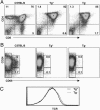Coevolution of TCR-MHC interactions: conserved MHC tertiary structure is not sufficient for interactions with the TCR
- PMID: 15883386
- PMCID: PMC1091755
- DOI: 10.1073/pnas.0502751102
Coevolution of TCR-MHC interactions: conserved MHC tertiary structure is not sufficient for interactions with the TCR
Abstract
The specificity for self-MHC that is necessary for T cell function is a consequence of intrathymic selection during which T cell antigen receptors (TCRs) expressed by immature thymocytes are tested for their affinity for self-peptide:self-MHC. The germ-line-encoded segments of the TCR, however, are believed to have an innate specificity for structural features of MHC molecules. We directly tested this hypothesis by generating a transgenic mouse system in which the protein HLA-DM is expressed at the surface of thymic cortical epithelial cells in the absence of classical MHC molecules. The specialized intracellular function of HLA-DM has removed this MHC class II-like protein from the evolutionary forces that have been hypothesized to shape TCR-MHC interactions. Our study shows that a structural mimic of MHC class II is not sufficient to appropriately interact with the TCRs expressed by developing thymocytes. This result emphasizes the unique complementarity of TCR-MHC interactions that are maintained by the evolutionary pressures dictated by positive selection.
Figures




References
-
- Kisielow, P. & von Boehmer, H. (1995) Adv. Immunol. 58, 87-209. - PubMed
-
- Sebzda, E., Mariathasan, S., Ohteki, T., Jones, R., Bachmann, M. F. & Ohashi, P. S. (1999) Annu. Rev. Immunol. 17, 829-874. - PubMed
-
- Ignatowicz, L., Kappler, J. & Marrack, P. (1996) Cell 84, 521-529. - PubMed
-
- Sant'Angelo, D. B., Waterbury, P. G., Cohen, B. E., Martin, W. D., Van Kaer, L., Hayday, A. C. & Janeway, C. A., Jr. (1997) Immunity 7, 517-524. - PubMed
-
- Surh, C. D., Lee, D. S., Fung-Leung, W. P., Karlsson, L. & Sprent, J. (1997) Immunity 7, 209-219. - PubMed
Publication types
MeSH terms
Substances
Grants and funding
LinkOut - more resources
Full Text Sources
Other Literature Sources
Molecular Biology Databases
Research Materials

